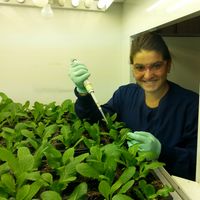Much like bacteria, fungus serve as a vital component of human society with a variety of important functions. For example, the food and pharmaceuitical industries rely heavily on fungal products. The microorganism that produces beer and bread is a fungus known as
Saccharomyces cerevisiae. Edible mushrooms are identified as vegetables and serve as a source of fiber and protein in the diet. Antibiotics including penicillin, cephalosporin, cyclosporine and statin drugs are all based on products produced by fungus. Engineers are also currently investigating the use of fungi in sustainable and biodegradable building and packing materials. Fungi are even important to the fashion industry where fungal enzymes are used to soften and fade denim jeans.
Fungi are also extremely important in nature where they are relied upon by plants to facilitate water and nutrient uptake. It is hypothesized that root-associated fungi enabled the initial colonization of land by plants millions of years ago. Fungi also help us to recycle by serving as the main decomposers of organic material. Given all of their important contributions it is not surprising that fungus, specifically mushrooms, are thought to have a positive impact on the ecosystem of tropical rainforests as well.
According to a research article published recently in
PLOS ONE, there are millions of tons of fungal spores that are dispersed in the atmosphere every year, many of which are produced by mushrooms. A specific type of fungal spore released by mushrooms, known as basidospores, form a significant proportion of aerosols above rainforests. An individual gilled mushroom can release 30,000 basidiospores per second. These spores have been shown, using high-speed video recordings in the 1980s, to be discharged from the gills of mushrooms by a catapult mechanism stimulated by a drop of fluid over the spore surface. This drop was previously identified as Buller’s drop, after the scientist who discovered this mechanism (A.H.R. Buller).
In the current study, researchers used environmental scanning electron microscopy (EEM) to analyze samples of basidiomycete fruit bodies from several different species of mushrooms. To analyze the behavior of spores upon dispersal, each spore was subjected to 2-4 changes in relative humidity. Using this technique they were able to show that liquid droplets reform on spores during periods of high humidity. These results indicate that these types of spores are particularly effective in the formation of large water droplets in clouds. This evidence suggests that mushroom basidiospores may influence rainfall in ecosystems where large populations of mushrooms thrive. Furthermore, scientists speculate that changes in climate that affect rainfall in tropical ecosystems may also cause inhibition in fungal growth, subsequently leading to an increased frequency in droughts.
Source:
PLOS ONE;
Kew









